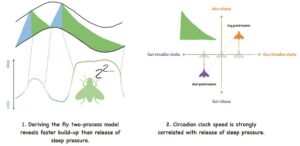Posted on December 11, 2023 in ASRC News, Neuroscience Initiative

The findings have possible implications for people with sleep phase disorders.
For decades, scientists have relied on a two-part model to explain the basic principles of sleep. These two processes include homeostasis — also known as the homeostatic sleep drive, or the pressure for sleep that increases with time spent awake — and circadian rhythms, the physiological changes that follow the 24-hour cycle. These two biological mechanisms interact to regulate sleep patterns in humans and mammals, but the question of how they affect one another remains unanswered.
In a new study, published in the journal SLEEP, researchers at the Advanced Science Research Center at the CUNY Graduate Center (CUNY ASRC) set out to test the model in the common fruit fly. Their work is the first time the model, formulated by sleep researchers in the early 1980s, has been formally adapted and tested in fruit flies, said first author Abhilash Lakshman , a postdoctoral research associate with the CUNY ASRC Neuroscience Initiative.
For their study, the research team asked two questions: Could the model explain the patterns and amount of sleep in fruit flies; and are the flies’ circadian clock speeds related to the speed of their sleep drive buildup and release? They found the model could explain sleep patterns in the flies, and they observed that the buildup of sleep drive was faster than the release of sleep drive. This was in stark contrast to humans and mammals, whose buildup of sleep drive is slower than its release. The difference may have to do with the fact that humans sleep much less than flies, who slumber 70% to 80% of a 24-hour period.

“Flies sleep in two phases: They have one peak of activity at dawn and another peak of activity at dusk,” Abhilash said. “They sleep once during the day and again at night in a two-stage pattern known as biphasic sleep.”
What the researchers really wanted to know, said Abhilash, is how quickly the drive to sleep builds and falls. Once they determined that answer, the next question was, what does the mathematical model predict about the amount of sleep that will occur. It turns out that the model’s prediction corresponded closely with the flies’ actual sleep pattern.
“The answer to the first question is, yes, there are parameter values which explain fly sleep well,” Abhilash said. “And when you look at those parameters, that’s when we find that the buildup is much, much faster than the decay.”
As a bonus, the flies’ internal circadian clock speed was clearly correlated with the release of sleep drive. If the internal circadian clocks are faster, the release of sleep drive is also faster, at least in the fly, which have relatively short windows of activity. In that small window of awake time, the sleep drive builds up quite rapidly.
While researchers don’t know if this model for the speed of sleep drive build and release in fruit flies correlates to human sleep patterns, the study points toward the possibility of a similar interplay in people. It is well known, for instance, that people with faster running internal clocks are also the ones that are referred to as morning larks. If the researcher team’s assessment holds for humans too, then these people are expected to have a different rate of sleep drive buildup and release than those who are night owls or who have sleep dysfunction. This may have implications in treating sleep disorders in people with different chronotypes.
The results, said the authors, establish the two-process model as a theoretical framework for building on research that might one day lead to treatments for disorders such as delayed sleep phase syndrome and advanced sleep phase disorder.
“The two-process model, despite its power to make quantitative predictions about how changes in the circadian clock wiåll affect sleep/wake cycles, has been underutilized by neuroscientists trying to understand the neural regulation of sleep,” said Orie Shafer, the study’s principal investigator and a faculty researcher with the CUNY ASRC Neuroscience Initiative. “In our case, the two-process model is making interesting and unexpected predictions for the fly that we would have never thought to examine. The model is therefore taking us in new and exciting directions experimentally.”
“This rigorous and exciting study performed by Dr. Shafer’s team is just one of several examples on how the group are addressing the burning questions regarding the process of sleep regulation, which plagues our society” said Patrizia Casaccia, executive director of the CUNY ASRC Neuroscience Initiative and a CUNY Graduate Center faculty member. “The beauty of the study in flies is that it allows us to finely manipulate parameters and obtain results which may be generalized to humans.”
This study was funded by the National Institutes of Health.
